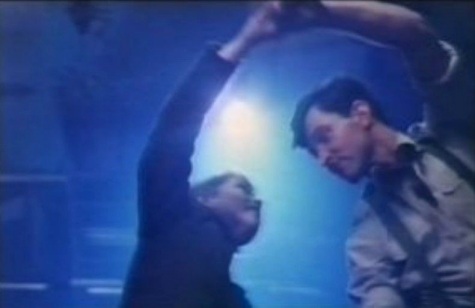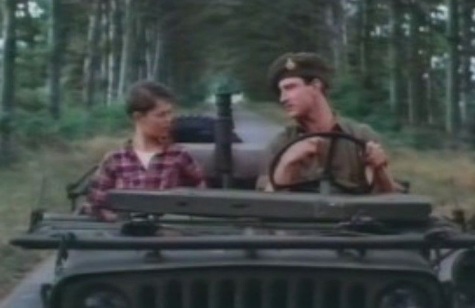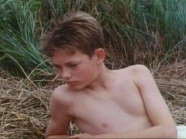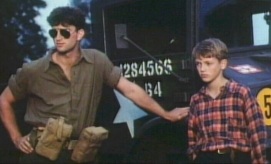|
Film
& Television
|

Maarten
Smit and Andrew Kelley as
Jeroen Boman and Walt Cook
For A Lost Soldier
|
by Frank Torey
|
IN THE AUTUMN
of 1944, the Allied troops had driven through Belgium and
the southern part of the Netherlands, but left the north still in the
grip
of the Germans. A strike was called by the Dutch railway workers, and
in
vengeance, the Germans cut off food and fuel to the area they still
held.
The so-called "hunger winter" followed. The Germans, of course, kept
themselves warm and well-fed, and continued to round up Jews and send
them
off to the torture and death camps (some 50,000 were shipped out of
Amsterdam alone). But many Amsterdammers starved and froze to death, as
the
last winter of the war turned out to be exceptionally severe. Those
parents
who could, sent their children away to host families in the countryside
where food was less scarce.
Rudi van Danzig was one of
those children. Until shortly after the
occupation ended the following spring, he lived with a fisher family in
the
northern province of Friesland. Over forty years later, in 1986, he
wrote a
fictionalized account of this experience -- a brooding, touching novel
entitled, "Voor een verloren soldaat". Remarkably, it deals in large
part
with the sexually expressed friendship he developed with a soldier in
the
Canadian army of liberation.

The Dutch critics found the film too "pretty," too "nice," in
comparison
with the darkly-hued novel. Probably what disturbed them most was that
in
the book the twelve-year-old boy has ambivalent feelings about this
first
sexual experience of his life (what the specific acts were is left up
to
the reader's imagination), while in the film, amazingly enough, the boy
is
simply and sunnily in love with the soldier and has few observable
problems
with the sex.
 Bad reviews coupled with the rather unusual
nature of the love story
soon pushed the film out of the major movie halls and into one small
theater in the west of Amsterdam, where over the summer of 1992 it was
patronized by a mixed audience of fellow-survivors of the hunger winter
and gays and boy-lovers. The latter tended to come back time after
time,
often bringing foreign friends and interpreting the dialogue for them
as
the film progressed.
Bad reviews coupled with the rather unusual
nature of the love story
soon pushed the film out of the major movie halls and into one small
theater in the west of Amsterdam, where over the summer of 1992 it was
patronized by a mixed audience of fellow-survivors of the hunger winter
and gays and boy-lovers. The latter tended to come back time after
time,
often bringing foreign friends and interpreting the dialogue for them
as
the film progressed.
The critics are right in one respect: "Voor een verloren soldaat" is no
unflawed masterpiece. A present-time frame in which the adult van
Danzig
(played by the Dutch-American actor Jeroen Krabbe) is rehearsing
dancers
for some sort of liberation-commemoration ballet gets the movie off to
a
bad start. But as soon as the film flashes back forty years to the war,
it
comes very much alive. We see the twelve-year-old boy bundled off at
dawn
into a truck with other children, many in a state of shock at being
separated from their parents. We see him slowly adjusting to the
simple,
deeply religious but warm-hearted fisherfolk and learning to understand
the Frisian language. Finally we watch him drawing the attention of the
Canadian soldier, flirting with him, falling in love, becoming his
lover,
and with anguish, losing him when the troops move on.
Martin Smit, who plays the boy, is nothing short of brilliant. He
possesses a face not only handsome but remarkably expressive. The part
calls for a great variety of moods. In a 1992 television talk show
interview, young Smit (by then fourteen) said he didn't have much
trouble
with the crying he had to do (he just thought about his mother dying),
but
laughing was often a problem: there was one scene where he thought his
laugh was false and it gave him the shivers every time he saw it. (This
reviewer didn't spot the place; the boy always seems natural and in
character.)
 Andrew Kelly is convincing as the
charismatic and somewhat enigmatic
Canadian soldier, hiding behind his dark glasses and never, amidst the
uncertainties of war, able to abandon himself emotionally to the boy
as the boy has abandoned himself to the soldier. He is an excellent
foil
to young Smit's fresh, magnetic presence.
Andrew Kelly is convincing as the
charismatic and somewhat enigmatic
Canadian soldier, hiding behind his dark glasses and never, amidst the
uncertainties of war, able to abandon himself emotionally to the boy
as the boy has abandoned himself to the soldier. He is an excellent
foil
to young Smit's fresh, magnetic presence.
There are many other excellencies of the film: the prosaic but always
honest camera work, the mis en scene in the same Frisian villages where
van
Danzig spent those wartime months, the touching portrayal by Freark
Smink
of the boy's foster father. Don Bloch's screenplay is good on the
whole,
and the direction by Roeland Kerbosch (who as a child had also been
sent to
Friesland during the hunger winter) is, like the camera work, sensitive
without being in any way idiosyncratic or obtrusive.
But what will interest readers most is the movie's exploration of the
relationship, emotional and physical, between the two lovers. Here the
film
has virtually no contemporary equal in honesty, frankness, or charm.
 There is one short scene in which the boy
and the soldier are just
getting to know one another. The soldier, driving a jeep, overtakes the
boy
walking home. He tells him to hop in, but the boy turns on his heel and
walks back in the opposite direction. The soldier puts the jeep into
reverse and backs up past the boy, who, head held high, has a slight
teasing smile on his lips. When the soldier starts to move forward
again,
the boy, now grinning broadly, reverses direction again and walks down
the
middle of the road in front of the jeep, not allowing it to pass. Smit
and
Kelly play out this little drama absolutely perfectly; in fact it
remains
in the viewer's mind long after some of the more dramatic moments have
faded from memory.
There is one short scene in which the boy
and the soldier are just
getting to know one another. The soldier, driving a jeep, overtakes the
boy
walking home. He tells him to hop in, but the boy turns on his heel and
walks back in the opposite direction. The soldier puts the jeep into
reverse and backs up past the boy, who, head held high, has a slight
teasing smile on his lips. When the soldier starts to move forward
again,
the boy, now grinning broadly, reverses direction again and walks down
the
middle of the road in front of the jeep, not allowing it to pass. Smit
and
Kelly play out this little drama absolutely perfectly; in fact it
remains
in the viewer's mind long after some of the more dramatic moments have
faded from memory.
The two lovers indulge in a lot of high-spirited horseplay, which when
the circumstances are right, leads to intimacies filmed with neither
embarrassment nor apology. We see man and boy kissing, stripping naked,
showering, climbing under the covers. There is one long, lovingly
photographed close-up of the boy's face as the soldier, lying upon him,
penetrates him anally. We see them later lying naked on the bed in
loose
embrace and in post-orgasmic bliss. All of this is handled in perfect
taste, of necessity with a minimum of words, since the boy speaks
little
English and the soldier no Dutch.
An English sub-titled version is now showing in North America, but the
dialogue is not terribly important in understanding the film; there
are,
after all, three languages spoken at various times -- Dutch, Frisian
and
English -- sometimes to the confusion of one character or another, so
meaning
is usually adequately conveyed by other means.
It is wonderful that in this time of world-wide puritanism a book that
depicts a man-boy sexual relationship in all of its troubling aspects
inspired a beautifully acted and well-produced film celebrating the
sunny
side of boy-love. It is as if the film-makers were saying, "Wait- it
doesn't have to be all this complicated and agonizing. The discovery of
physical love, even at age twelve, can be a happy, precious thing."
Once
again we see that there really are people in the world who recognize
the
child abuse industry's malign image of the boy-lover for what it is:
opportunistic propaganda no better than the Nazi's depiction of the
predatory Jew, Gypsy, and homosexual which was part and parcel of the
great European tragedy against which this luminous film is set.
|
From
Gayme, Vol. 1, No.
1, Pgs. 40 - 42, Sept 1993
|
Copyright © NAMBLA, 2006
|
|
|
|
|

